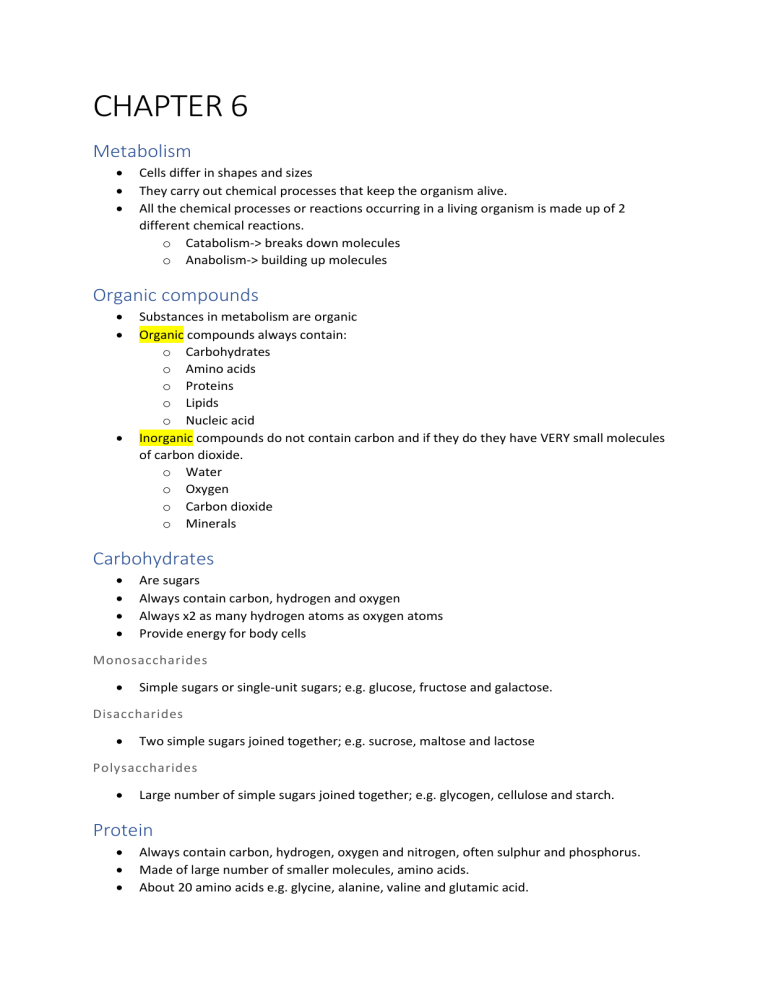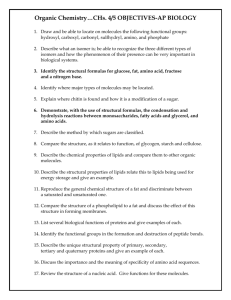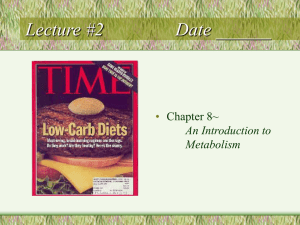METABOLISM CH6
advertisement

CHAPTER 6 Metabolism Cells differ in shapes and sizes They carry out chemical processes that keep the organism alive. All the chemical processes or reactions occurring in a living organism is made up of 2 different chemical reactions. o Catabolism-> breaks down molecules o Anabolism-> building up molecules Organic compounds Substances in metabolism are organic Organic compounds always contain: o Carbohydrates o Amino acids o Proteins o Lipids o Nucleic acid Inorganic compounds do not contain carbon and if they do they have VERY small molecules of carbon dioxide. o Water o Oxygen o Carbon dioxide o Minerals Carbohydrates Are sugars Always contain carbon, hydrogen and oxygen Always x2 as many hydrogen atoms as oxygen atoms Provide energy for body cells Monosaccharides Simple sugars or single-unit sugars; e.g. glucose, fructose and galactose. Disaccharides Two simple sugars joined together; e.g. sucrose, maltose and lactose Polysaccharides Large number of simple sugars joined together; e.g. glycogen, cellulose and starch. Protein Always contain carbon, hydrogen, oxygen and nitrogen, often sulphur and phosphorus. Made of large number of smaller molecules, amino acids. About 20 amino acids e.g. glycine, alanine, valine and glutamic acid. Bond between amino acids is called a peptide bond. Two amino acids joined by a peptide bond is a dipeptide Ten or more amino acids joined is a polypeptide. Proteins consist of 100 or more amino acids. Each protein chain of amino acids is folded in a unique way. Proteins are important structural materials in body. Enzymes= proteins .˙. proteins are involved in all the chemical reactions of the body. Nucleic acids Large molecules Made of carbon, hydrogen, nitrogen and phosphorus Made up of nucleotides o Nitrogen base o Sugar o Phosphate Main types of nucleotides o Ribonucleic acid (RNA) o Deoxyribonucleic acid (DNA) RNA carries information from the DNA in the nucleus to parts of the cell where proteins are made. Lipids Contain carbon, hydrogen and oxygen, much less oxygen than the amount of oxygen in carbohydrates. Example of lipids o Fats; stored in the body as energy reserves o Phospholipids; important in cell membranes o Steroids; cholesterol and in sex hormones Each fat molecule is made of 1glycerol molecule and 1, 2 or 3 fatty acid molecules. Type of fat stored in the body (98% of fat in foods) is triglyceride – glycerol + 3 fatty acids. DNA Consists of 2 chains of nucleotides that contain the sugar deoxyribose. DNA is the genetic material in the nucleus that stores inherited information. o AT-CG-TA-GC RNA Consists of a single chain of nucleotides that contain the sugar ribose. RNA carries information from the DNA in the nucleus to parts of the cell where proteins are made. Enzymes Proteins used by cells to lower activation energy of a reaction. o Active site – site on enzyme surface where reactant fits o Binding site – site on reactant that binds to enzyme Enzyme only speeds up its reaction. Enzyme + substrate -> enzyme – substrate complex -> enzyme + products Reactant and products Exergonic – products contain less energy than reactants. Endergonic – products contain more energy than reactants. Activation energy – extra energy required to destabilise chemical bonds and initiate a chemical reaction. Factors affecting enzyme activity It may alter the enzymes 3-dimensional shape. o o o o o o Concentration of enzyme Substrate concentration Removal of product Temperature PH CO. factors Concentration of enzyme and substrate Higher the concentration of the enzyme, the faster the rate of chemical reaction. Increasing substrate concentration also increases the rate of the reaction. Enzyme and temperature Temperature rise = enzymes work faster Heat destroys the special shape of the protein chain and the substrate doesn’t fit. Work best at certain PH Optimum at 7 (neutral) some prefer acid (low PH), some prefer alkaline (high PH). PH CO. factors Ions or non-protein molecules which help to catalyse a reaction. CO enzyme – non-protein organic molecule acting as a CO. factor. E.g. Vitamins Enzyme inhibitors Slow or stop enzyme activity Can control reactions Many drugs are inhibitors o Penicillin inhibits enzyme in bacteria that is involved in construction of the cell wall. Cellular respiration Glucose + Oxygen -> Carbon dioxide + water + energy Simplified takes place>20 separate reactions Intermediate compounds formed, catalysed by different enzymes. Controlled release of energy. o Glycolysis (lysis means breakdown) -> anaerobic o Krebs cycle ->aerobic o Electron transport system ->aerobic Energy Glucose breakdown results in 60% heat (maintains constant body temp). Remaining energy is used to form ATP. ATP is formed when an inorganic phosphate group is joined to molecule of ADP. ADP is reused. ATP is a way of transforming energy to cell processes. ATP CYCLE Anaerobic Respiration Glycolysis – occurs in the cytosol (anaerobic respiration enzymes located there) Glucose -10 steps-> 2 pyruvic acids + 2 ATP -no O2 available-> lactic acids -> travels to liver + O2 (produces glucose and glycogen) Aerobic respiration Occurs in the mitochondria (where the folded inner membrane has a higher surface area – contains enzymes needed for aerobic respiration). Aerobic respiration creates 6CO2, 6H2O and heat as products. Pyruvic acid -enters mitochondria Krebs cycle ->2 ATP Electron transport system ->34 ATP Energy use by the cell Cells need energy that is temporarily stored in ATP molecule. Synthesis Process of combining of small molecules to make larger molecules <- same as anabolism. Cells at work Water- Most valuable item Vitamins- compounds that com in either fat soluble or water-soluble form -Vitamin C-> improves iron absorption -Vitamin K-> crucial to blood clotting -Vitamin B-> important in the production of ATP from glucose Minerals- Calcium. Magnesium and Phosphorus –> harden bone -iron-> crucial part of haemoglobin -potassium, sodium and chlorine -> maintain your body’s PH balance Carbohydrates- monosaccharides -> simple sugars -disaccharides -> big lots of simple sugars -polysaccharides -> starches from vegies or grains -glucose -> (monosaccharide) essential in ATP production -Catabolize -> turning ATP to glucose Lipids- stored in the adipose, used for the phospholipids, myelin… Proteins- Muscles, connective tissue and ion channels. MAKE ENZYMES!


